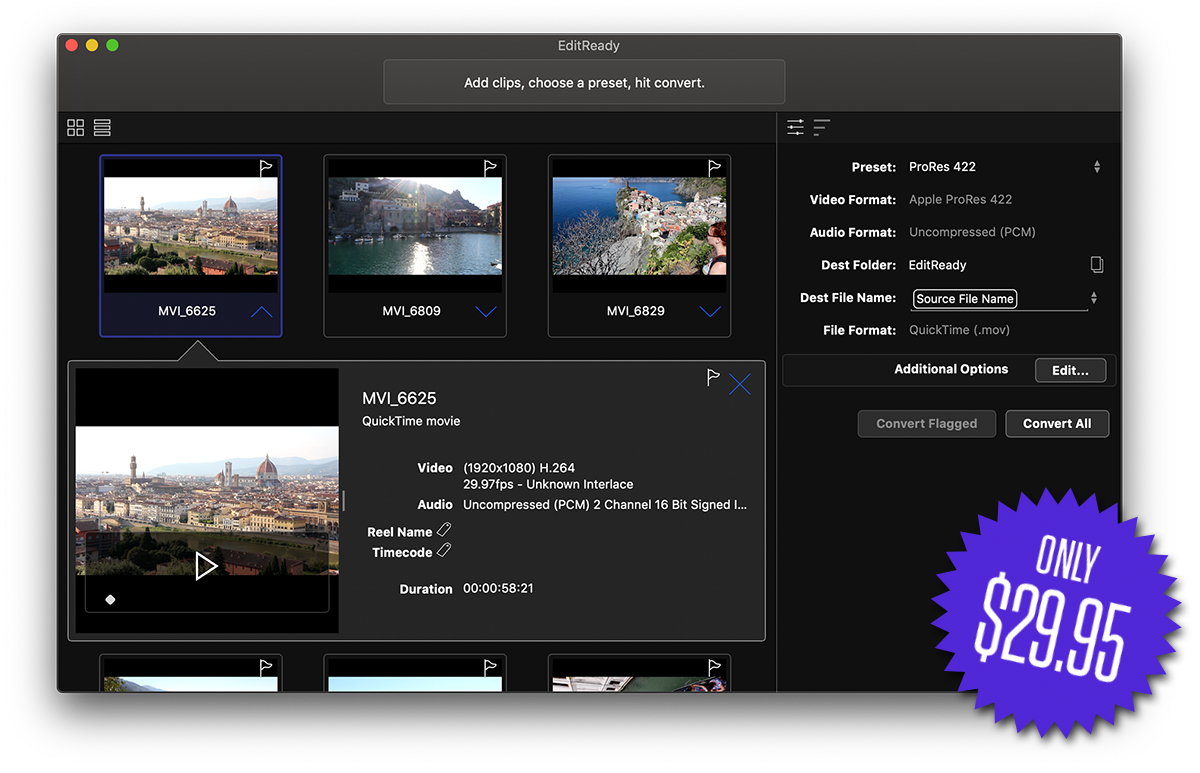

58 Seconds for ProRes 422 - Clip Size 784MB.

50 Seconds for ProRes 422 LT - Clip Size: 432MB.Here are my results as I encoded the clip into 3 different flavors of ProRes in both EditReady and Media Encoder:
#Editready output to mp4 full#
The original clip was full HD, and the original file size was 274MB. I used a single 57 second h.264 clip shot on my Canon 60D to conduct my test. However, once I started using EditReady (and comparing it to Adobe Media Encoder, which is what I normally use for all of my encoding), what I found was pretty impressive. Unfortunately, EditReady is a Mac-only app, so in order to test its speed and overall performance, I had to use the Macbook.Ĭoming into the conversion process, I had been expecting all of my tests to be painfully slow because, frankly, the Macbook is on its last leg. Suffice it to say, I would NEVER choose to do transcoding work on the Macbook unless it was absolutely necessary. Back in the day, the Macbook was no slouch in terms of performance, but time has not been kind to it, and the performance these days is pretty underwhelming.
#Editready output to mp4 pro#
I own two computers, a mid 2010 Macbook Pro with a dual core 2.66GHz i7 processor and 8GB of RAM, and a custom-built editing PC that is insanely beefy in terms of specs and raw power.


But, before we do, a primer on the computer that I used to test the software. Audio formats can also differ, such as one supporting Dolby AC-3 while another supports PCM (it varies from camera to camera, so check the manual).Now let's talk about performance. Many cameras also offer higher resolutions such as 4K in XAVC, something which AVCHD doesn’t support due to being an older container. So pick based on which bitrate you prefer. In XAVC however, it only runs at 50mpbs regardless if you record in 30p or 60p. In 1080i, AVCHD has 4 record modes ranging from 5mbps to 24, and in 1080p60, records at 28mbps. I have a Sony Handycam which supports both, and AVCHD supports 5 different bit rates. Noticeably, XAVC generally uses higher bitrates compared to AVCHD. The main difference between the two is that AVCHD was originally intended for rotational media such as DVD, Blu-Ray and HDD, while XAVC was designed for faster solid state storage, such as flash and SSD drives. Both use the h.264 codec for video, also known as AVC or Advance Video Coding (hence why both use AVC in the name). They are basically just different container files, with AVCHD created in 2006 and XAVC in 2012. (since H.265 will not probably work on a lot of TVs i think) That selecting "H.264 (VideoToolbox)" as encoder engine in the video tab, right? although Handbrake with T2 & Quicksync support seems a win.
#Editready output to mp4 mp4#
Should i change recording to use XAVC-S format which outputs MP4 files for more compatibility and probably ease of editing in iMovie?įor the already existing bunch of MTS files, what converter do you recommend (except handbrake) that makes use of Intel QuickSync? I have a 2018 Mac Mini i5 which supports QS.and also has the T2 chip. if they're not in the original folder structure. However some TVs have issues with MTS files, esp. This SSD will be used to plug in TV to playback the video library. I "showed contents" of the card all the way to the MTS files, which i backup-ed over to an external SSD. Given a Sony camera that records in both AVCHD and XAVC-S, what is the recommended recording format to use if i'm going to edit the files on a Mac?Ĭurrently there's a bunch of blu-ray folder structures on the sdcard because it was set to record in AVCHD.


 0 kommentar(er)
0 kommentar(er)
